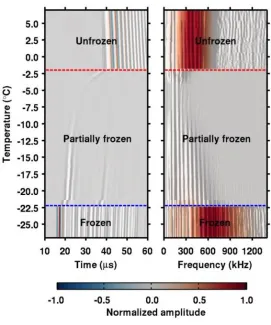Saline permafrost usually is in a delicate state of being partially frozen, which makes it mechanically weak and sensitive to temperature disturbances. Consequently, the overall stability of the saline permafrost systems could be under threat in a warming world. Therefore, knowledge about the distributions and properties of saline permafrost is in high demand. Seismic methods are useful for mapping and monitoring saline permafrost at scales of geotechnical interest, but relevant research is lacking. In a unique series of field and laboratory studies conducted by NGEE Arctic researchers, Shan Dou and her colleagues at LBNL systematically examined ultrasonic P-wave properties (velocity and attenuation) of saturated, unconsolidated saline permafrost from the Barrow Environmental Observatory (BEO), near Barrow, AK. Measurements were conducted on both synthetic and natural saline permafrost samples over a broad range of pore-water salinities and temperatures. The key observations made by Dou et al. include marked velocity reductions, strong attenuation, and complex waveform variations that are associated with the partially frozen state of the samples. The most important contribution of these investigations is a rich data set that records in great detail how P-wave properties of saturated, unconsolidated saline permafrost vary with respect to temperature, pore-water salinity, and sediment type. Moreover, the data set should allow researchers to examine the relationship between ice content and P-wave properties, and subsequently gain insights regarding pore-scale distributions of ice. The data set and the associated realizations of the pore-scale structures provide valuable bases for rock physics modeling, which could ultimately facilitate seismic characterizations of saline permafrost.
In figure 2, The green curves in (a) correspond to model-predicted P-wave velocities for three end-member rock physics models: 1, the stiffest cementation model, in which ice occurs and cements at grain contacts; 2, the second stiffest cementation model, in which ice coats and cements grains; 3, the softest pore-filling model, in which ice floats in pore space.
1)The evolution of the P-wave waveforms (left panel) and the corresponding amplitude spectra (right panel) over the course of a freeze-only measurement conducted on one of the saline coarse sand samples (initial pore-water salinity = 0.6 M (35 ppt)). Relative amplitudes of the signals are preserved.
For more information, please contact:
Shan Dou
Jonathan Ajo-Franklin


